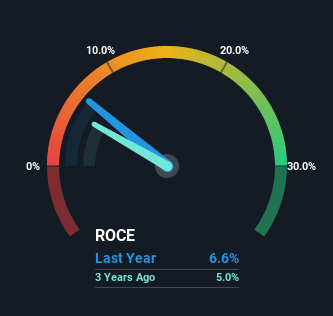- Malaysia
- /
- Household Products
- /
- KLSE:NTPM
Capital Allocation Trends At NTPM Holdings Berhad (KLSE:NTPM) Aren't Ideal
What financial metrics can indicate to us that a company is maturing or even in decline? When we see a declining return on capital employed (ROCE) in conjunction with a declining base of capital employed, that's often how a mature business shows signs of aging. This combination can tell you that not only is the company investing less, it's earning less on what it does invest. In light of that, from a first glance at NTPM Holdings Berhad (KLSE:NTPM), we've spotted some signs that it could be struggling, so let's investigate.
Return On Capital Employed (ROCE): What Is It?
Just to clarify if you're unsure, ROCE is a metric for evaluating how much pre-tax income (in percentage terms) a company earns on the capital invested in its business. Analysts use this formula to calculate it for NTPM Holdings Berhad:
Return on Capital Employed = Earnings Before Interest and Tax (EBIT) ÷ (Total Assets - Current Liabilities)
0.066 = RM39m ÷ (RM1.1b - RM473m) (Based on the trailing twelve months to July 2022).
So, NTPM Holdings Berhad has an ROCE of 6.6%. In absolute terms, that's a low return and it also under-performs the Household Products industry average of 9.0%.
Check out the opportunities and risks within the XX Household Products industry.

Above you can see how the current ROCE for NTPM Holdings Berhad compares to its prior returns on capital, but there's only so much you can tell from the past. If you're interested, you can view the analysts predictions in our free report on analyst forecasts for the company.
What Can We Tell From NTPM Holdings Berhad's ROCE Trend?
In terms of NTPM Holdings Berhad's historical ROCE movements, the trend doesn't inspire confidence. About five years ago, returns on capital were 16%, however they're now substantially lower than that as we saw above. Meanwhile, capital employed in the business has stayed roughly the flat over the period. Since returns are falling and the business has the same amount of assets employed, this can suggest it's a mature business that hasn't had much growth in the last five years. So because these trends aren't typically conducive to creating a multi-bagger, we wouldn't hold our breath on NTPM Holdings Berhad becoming one if things continue as they have.
On a side note, NTPM Holdings Berhad's current liabilities have increased over the last five years to 44% of total assets, effectively distorting the ROCE to some degree. Without this increase, it's likely that ROCE would be even lower than 6.6%. What this means is that in reality, a rather large portion of the business is being funded by the likes of the company's suppliers or short-term creditors, which can bring some risks of its own.
The Bottom Line
All in all, the lower returns from the same amount of capital employed aren't exactly signs of a compounding machine. It should come as no surprise then that the stock has fallen 32% over the last five years, so it looks like investors are recognizing these changes. That being the case, unless the underlying trends revert to a more positive trajectory, we'd consider looking elsewhere.
NTPM Holdings Berhad does come with some risks though, we found 4 warning signs in our investment analysis, and 2 of those are a bit unpleasant...
While NTPM Holdings Berhad may not currently earn the highest returns, we've compiled a list of companies that currently earn more than 25% return on equity. Check out this free list here.
Valuation is complex, but we're here to simplify it.
Discover if NTPM Holdings Berhad might be undervalued or overvalued with our detailed analysis, featuring fair value estimates, potential risks, dividends, insider trades, and its financial condition.
Access Free AnalysisHave feedback on this article? Concerned about the content? Get in touch with us directly. Alternatively, email editorial-team (at) simplywallst.com.
This article by Simply Wall St is general in nature. We provide commentary based on historical data and analyst forecasts only using an unbiased methodology and our articles are not intended to be financial advice. It does not constitute a recommendation to buy or sell any stock, and does not take account of your objectives, or your financial situation. We aim to bring you long-term focused analysis driven by fundamental data. Note that our analysis may not factor in the latest price-sensitive company announcements or qualitative material. Simply Wall St has no position in any stocks mentioned.
About KLSE:NTPM
NTPM Holdings Berhad
An investment holding company, manufactures and distributes tissue paper and personal care products in Malaysia, Singapore, Thailand, Vietnam, and internationally.
Low risk and slightly overvalued.
Market Insights
Community Narratives


Recently Updated Narratives

Constellation Energy Dividends and Growth

CoreWeave's Revenue Expected to Rocket 77.88% in 5-Year Forecast

Bisalloy Steel Group will shine with a projected profit margin increase of 12.8%
Popular Narratives


MicroVision will explode future revenue by 380.37% with a vision towards success


NVDA: Expanding AI Demand Will Drive Major Data Center Investments Through 2026



